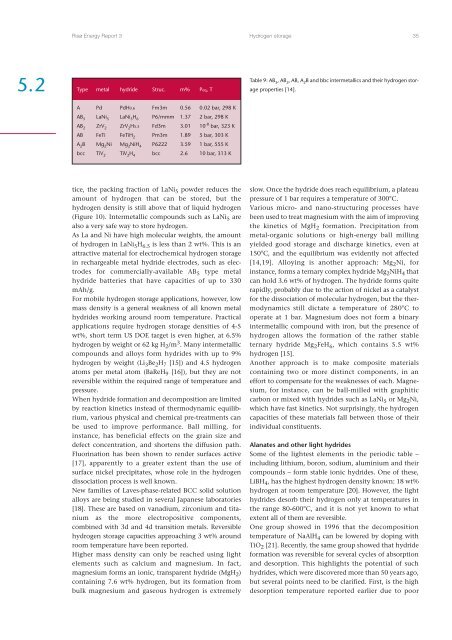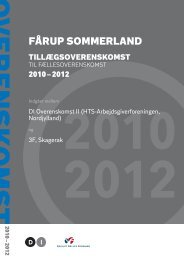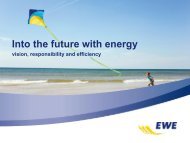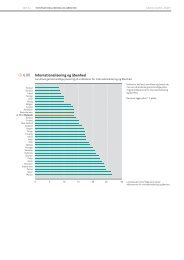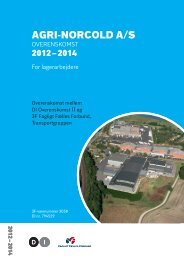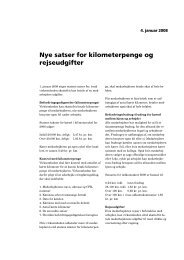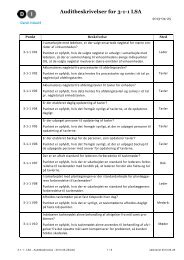Hydrogen and its competitors, 2004
Hydrogen and its competitors, 2004
Hydrogen and its competitors, 2004
You also want an ePaper? Increase the reach of your titles
YUMPU automatically turns print PDFs into web optimized ePapers that Google loves.
Risø Energy Report 3<strong>Hydrogen</strong> storage 355.2Type metal hydride Struc. m% Peq, TTable 9: AB 5 , AB 2 , AB, A 2 B <strong>and</strong> bbc intermetallics <strong>and</strong> their hydrogen storageproperties [14].A Pd PdH0.6 Fm3m 0.56 0.02 bar, 298 KAB 5 LaNi 5 LaNi 5 H 6 P6/mmm 1.37 2 bar, 298 KAB 2 ZrV 2 ZrV 2 H5.5 Fd3m 3.01 10 -8 bar, 323 KAB FeTi FeTiH 2 Pm3m 1.89 5 bar, 303 KA 2 B Mg 2 Ni Mg 2 NiH 4 P6222 3.59 1 bar, 555 Kbcc TiV 2 TiV 2 H 4 bcc 2.6 10 bar, 313 Ktice, the packing fraction of LaNi 5 powder reduces theamount of hydrogen that can be stored, but thehydrogen density is still above that of liquid hydrogen(Figure 10). Intermetallic compounds such as LaNi 5 arealso a very safe way to store hydrogen.As La <strong>and</strong> Ni have high molecular weights, the amountof hydrogen in LaNi 5 H 6.5 is less than 2 wt%. This is anattractive material for electrochemical hydrogen storagein rechargeable metal hydride electrodes, such as electrodesfor commercially-available AB 5 type metalhydride batteries that have capacities of up to 330mAh/g.For mobile hydrogen storage applications, however, lowmass density is a general weakness of all known metalhydrides working around room temperature. Practicalapplications require hydrogen storage densities of 4-5wt%, short term US DOE target is even higher, at 6.5%hydrogen by weight or 62 kg H 2 /m 3 . Many intermetalliccompounds <strong>and</strong> alloys form hydrides with up to 9%hydrogen by weight (Li 3 Be 2 H 7 [15]) <strong>and</strong> 4.5 hydrogenatoms per metal atom (BaReH 9 [16]), but they are notreversible within the required range of temperature <strong>and</strong>pressure.When hydride formation <strong>and</strong> decomposition are limitedby reaction kinetics instead of thermodynamic equilibrium,various physical <strong>and</strong> chemical pre-treatments canbe used to improve performance. Ball milling, forinstance, has beneficial effects on the grain size <strong>and</strong>defect concentration, <strong>and</strong> shortens the diffusion path.Fluorination has been shown to render surfaces active[17], apparently to a greater extent than the use ofsurface nickel precipitates, whose role in the hydrogendissociation process is well known.New families of Laves-phase-related BCC solid solutionalloys are being studied in several Japanese laboratories[18]. These are based on vanadium, zirconium <strong>and</strong> titaniumas the more electropositive components,combined with 3d <strong>and</strong> 4d transition metals. Reversiblehydrogen storage capacities approaching 3 wt% aroundroom temperature have been reported.Higher mass density can only be reached using lightelements such as calcium <strong>and</strong> magnesium. In fact,magnesium forms an ionic, transparent hydride (MgH 2 )containing 7.6 wt% hydrogen, but <strong>its</strong> formation frombulk magnesium <strong>and</strong> gaseous hydrogen is extremelyslow. Once the hydride does reach equilibrium, a plateaupressure of 1 bar requires a temperature of 300°C.Various micro- <strong>and</strong> nano-structuring processes havebeen used to treat magnesium with the aim of improvingthe kinetics of MgH 2 formation. Precipitation frommetal-organic solutions or high-energy ball millingyielded good storage <strong>and</strong> discharge kinetics, even at150°C, <strong>and</strong> the equilibrium was evidently not affected[14,19]. Alloying is another approach: Mg 2 Ni, forinstance, forms a ternary complex hydride Mg 2 NiH 4 thatcan hold 3.6 wt% of hydrogen. The hydride forms quiterapidly, probably due to the action of nickel as a catalystfor the dissociation of molecular hydrogen, but the thermodynamicsstill dictate a temperature of 280°C tooperate at 1 bar. Magnesium does not form a binaryintermetallic compound with iron, but the presence ofhydrogen allows the formation of the rather stableternary hydride Mg 2 FeH 6 , which contains 5.5 wt%hydrogen [15].Another approach is to make composite materialscontaining two or more distinct components, in aneffort to compensate for the weaknesses of each. Magnesium,for instance, can be ball-milled with graphiticcarbon or mixed with hydrides such as LaNi 5 or Mg 2 Ni,which have fast kinetics. Not surprisingly, the hydrogencapacities of these materials fall between those of theirindividual constituents.Alanates <strong>and</strong> other light hydridesSome of the lightest elements in the periodic table –including lithium, boron, sodium, aluminium <strong>and</strong> theircompounds – form stable ionic hydrides. One of these,LiBH 4 , has the highest hydrogen density known: 18 wt%hydrogen at room temperature [20]. However, the lighthydrides desorb their hydrogen only at temperatures inthe range 80-600°C, <strong>and</strong> it is not yet known to whatextent all of them are reversible.One group showed in 1996 that the decompositiontemperature of NaAlH 4 can be lowered by doping withTiO 2 [21]. Recently, the same group showed that hydrideformation was reversible for several cycles of absorption<strong>and</strong> desorption. This highlights the potential of suchhydrides, which were discovered more than 50 years ago,but several points need to be clarified. First, is the highdesorption temperature reported earlier due to poor


